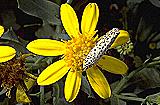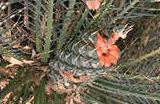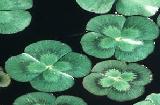|
[Front Page] [Features] [Departments] [Society Home] [Subscribe]

Edible Plants
Bob Shoebridge
Our knowledge of native Australian edible plants is sketchy due to the early destruction of Aboriginal culture. Disease, genocide and active discrimination, coupled with very little being recorded by the invading Europeans, has left us with a limited number of known edible species and often these were recorded by a single, ill-informed source. Therefore early records of edible plants need to be treated with some caution, since many of these plants require complex preparation before they can be eaten, eg mangrove seed.
There is another problem that no apparent selection had been made by the Aboriginal people of plants for a better-yielding food staple. Probably, Australian native plants will never form a food staple with, perhaps, the sole exception being the macadamia nut - its commercial viability being due to the Americans!
Toxins
Before eating native plants it is a help to know the array of poisons which can confront you. If it is natural it is not necessarily safe. Toxins tend to be in family or genus groups; some of the major ones are:
- Glycosides - These work on the heart, and cause vomiting and purging. Solanaceae and many plants with milky latex sap, eg Apocynaceae, have glycosides.
- Serotins - To check for this toxin, grind the plant, shake vigorously with water or boil, then stand. If the resulting froth is stable after half an hour, reject the plant as it contains the toxin. Nicotiana, Duboisia and Derris all have this poison.
- Cyanide - Species containing this poison often taste and smell of benzaldehyde (bitter almonds). Many nuts have cyanide which can be removed by a process of boiling and washing.
- Alkaloids - These are often very bitter and work mainly on the central nervous system. Alkaloids are found in Solanaceae and Senecio.
- Oxalic Acid - Comes in two forms: one burns the mouth whilst the other combines with body calcium to form kidney stones. The soluble oxalates are usually sour, and the main plant families containing this toxin include Polygonaceae and Oxalidaceae.
Some Dangerous Plants
Click on thumbnail images or plant names for larger images |
 |
 |
 |
 |
| Left to right: Senecio magnificus, Solanum sturtianum, Macrozamia communis and Marsilea mutica (members of the genus Marsilea can cause vitamin B deficiency and have been implicated in the ill-fated Burke and Wills exploration. |
| Photos: Brian Walters; Shortland Wetland Centre |
Unfortunately, toxin levels can vary from year to year, concentrate more highly in different plant parts, and be influenced by plant maturity. People can differ in their reactions to plant poisons.
Some poisons have a cumulative effect: for instance, the toxin in ferns destroys body vitamin B but is dangerous only if normal levels of vitamin B are not maintained. Eat foods rich in this vitamin whilst consuming ferns.
Many fungi are edible although quite poor in terms of nutrition, ie vitamins, protein, etc. If unable to be positively identified they are not worth eating, as the poisonous varieties are extremely toxic and heat stable.
Nutrition
The major human food requirement is energy (fat and carbohydrates). Most of the Australian flora either has low food value or is difficult to gather in large enough quantities to be worth the energy expended in both collection and preparation.
- Shoots and berries are the most cost-effective, energy wise, since large quantities can be collected on the run, need no preparation, and are highly digestible. Berries also form a valuable source of water.
- Leaves contain too much cellulose to be a good food source. Approximately 11 kg would need to be eaten to satisfy daily requirements.
- Bulbs, tubers and rhizomes require some effort to dig out and prepare, but they do have a relatively high nutritional status.
- Seed has high food value, but presents difficulties in collection and preparation.
- Much of our flora yields good quantities of nectar, and some flowers such as Wahlenbergia can be eaten whole.
Some Edible Plants
| |
 |
| |
Macadamia nuts (Proteaceae) are the basis of major industries both in Australia and overseas |
- Orchidaceae: virtually all bulbs are edible.
- Myrtaceae, Proteaceae and Xanthorrhoeaceae: are excellent sources of nectar. Proteaceae seed is also edible.
- Epacridaceae: all soft fruits are edible and some flowers contain useful quantities of nectar.
- Solanaceae: generally a family to avoid. Some species which are edible need to have very ripe fruit.
- Asteraceae: most of the daisy group (the major exception being Senecio) are edible, if not palatable.
- Grasses and Sedges: have seeds, rhizomes and shoots which can be used after a fair amount of preparation.
- Ferns: the tips (fiddles) can be used following removal of the hairs. The rhizomes can be pounded and baked. The pith of tree ferns can also be eaten. Beware of the vitamin B destroying properties of ferns.
From 'Growing Australian', newsletter of the Australian Plants Socirty (Victoria).

[Front Page] [Features] [Departments] [Society Home] [Subscribe]
Australian Plants online - September 2004
Association of Societies for Growing Australian Plants
|